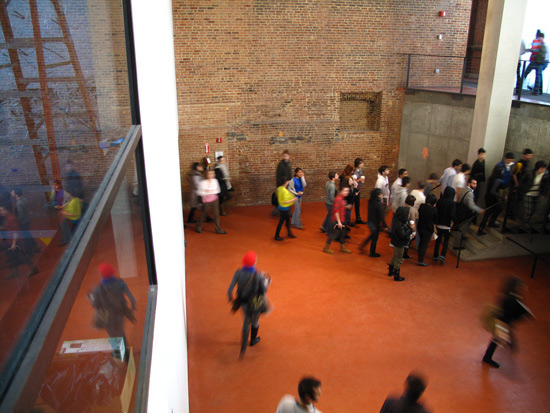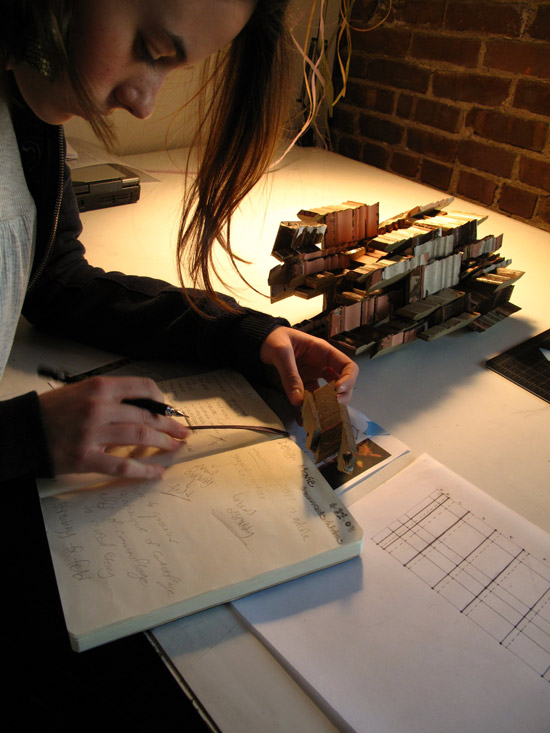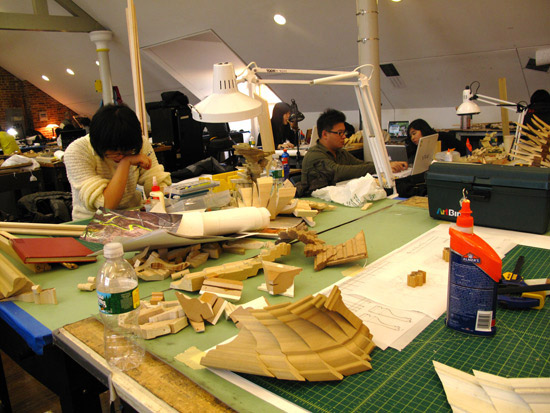Saturday, April 14, 2007
Late morning
Approximately 240 hours until Final Review
Sunlight floods through skylights in a vast loft and washes over a scene of filth and chaos. Gutted Chinese food cartons, crumpled sandwich wraps, abandoned ice cream tubs oozing at the seams, razors, rulers, energy drinks, sawdust, tape, foamcore, and glue lie heaped and scattered across 40 tabletops. It is only the occasional odd structure, delicate and meticulously crafted, or the intricate drawings of complex geometry, or the laboriously worked models tossed in with the debris, that reveal this to be a place where architecture is conceived and designs struggle to find form.
This morning, in the far left corner of the studio, half a dozen young men and women are working quietly. They are first-year undergraduate students at the Pratt Institute’s School of Architecture in Brooklyn, New York. In just 10 days they have their end-of-the-year final review, where they will present their semester’s work to a jury of professors and professionals and be judged for the sophistication of their thought and the beauty and quality of their craft.
Ezra G., 19, sprawls on his stool. He stares at his laptop and sketches a complex diagram on the paper covering of his table.

“Okay Ezra, looks like you’re going to be first,” says Evan Tribus, instructor for one of the four classes that share this studio space. Tribus has come in the past several Saturdays, in addition to class time, to offer his 10 students what assistance and advice he can. He circles Ezra’s desk. So far, Ezra’s model is a sheet of intricately interconnected paper cones that look more like a scaly pelt than anything pertaining to a building. Next to it are strewn an abundance of sketches, diagrams, and equations.
“So, these are your underwater viewing chambers?” Tribus asks, peering at one of the drawings.
“Yeah …” Ezra drops the pen, wipes a hand across his face, and blinks hard. He is tall. He has wide shoulders, hair the color of pale ale, and carries himself with the loose-limbed confidence of an athlete. He is from the mountains of North Carolina and knows how to kill a deer, rebuild a motorcycle engine, and survive in the woods for days if necessary.
“Show me again how you’re going to accommodate the ocean currents,” says Tribus.
Ezra pokes his model impatiently and explains something of the engineering principles behind the structure it represents — a building of sorts that would float on the ocean surface, flush visitors through a dizzying array of water tunnels, wind halls, and pitching chambers, and guarantee them a “nauseatingly visceral” experience sure to inspire meditation on such topics as control, fate, fear, and liberation.
Tribus nods solemnly. “Okay. Great. But looks like you’ve got a lot of work to do.”
Several tables down from Ezra is Eunice K., also 19. Her desk is littered with gritty, graying pieces of paper that have clearly been glued, pulled apart, and re-glued multiple times. For some reason Eunice has replaced her stool with a shopping cart. Seated in the cart, her head barely rises above the table’s edge. Tribus surveys her table.
“I don’t have any new work,” she says quietly.
“Nice seat,” says Tribus. “You want to talk about that?”
“There’s nothing to talk about.”
“Look, your drawings are really nice. Make sure you present them at final too, okay? It’s important to show your process.”
The studio door swings open. A young man in shorts and flip-flops huffs in, weaves noisily between the desks, and drops his backpack with a thud by the table in the corner.
“How are you, Eric?” asks Tribus.
“Bad. Stupid upperclassman. Totally took over the laser cutter. They wouldn’t let me use it at all.”
Like most other students, Eric has pictures, notes, and mementos of personal significance around his desk. Among his are photographs from several of his high school’s theater productions. He loves theater. He thought he might want to study set design, but his father graduated from Pratt’s School of Architecture, and his older brother attends currently. All things considered, Eric explained, he decided that architecture maybe was the more practical field to pursue.
The other students’ models are fanciful structures, scarcely distinguishable as architecture, but Eric’s is distinctly a building. It has a smooth floor, a hint of stairs, and a watermelon-sized domed ceiling.
There is a long moment of quiet while Tribus gazes at Eric’s model.
“Your dimensions are all wrong,” he says eventually. “You want these to be stairs, right? Do you see? They’re way too steep.”
“Mmmmmm,” says Eric.

There are apparently other problems too, something to do with the whole concept of the piece. Tribus urges Eric to consider the viewer-viewee relationship more carefully, to think in terms of feeling rather than literally, to try to convey a mood. Eric glances out the window. Tribus shrugs. “Look … I can’t make you do it, but I think it would make your project better,” and he moves on.
Charrette is a French word meaning chariot, wagon, or cart. According to legend, in the 19th century at L’Ecole des Beaux Arts in Paris, students’ work was gathered up and whisked off for review by means of a horse-drawn cart. Students working frantically until the last minute would leap onto the cart and make final changes en charrette as it trundled to its destination. Now, for those in the design profession, the term refers to final crunch time before a deadline — usually a period of sleepless nights and frenzied productivity.
In April 2007, all architecture students enrolled at Pratt were in charrette, getting ready for their respective classes’ final reviews. For first-year students the pressure is particularly acute. The relentless workload and harsh critiques of the first year are designed to cull out any who might prove insufficiently bright or dedicated to pass in the program.
“Look, if I had my way,” Tribus says one evening over dinner at a restaurant near Pratt, “they’d never leave the building. I want them there all day, every day. If you sleep, sleep there. If you need something, order in.”
Tribus is a smallish man with a tidy goatee and a sharp, intelligent gaze. He stares at me over the noodles.
“You think I’m kidding,” he says. “I’m not.”
Charrette, he tells me, can be a remarkable time too, as long as people engage in it wholeheartedly.
“Charrette is a really special time. The sheer fact of so many people working together in a contained space, so intensely … it generates an incredible creative energy. Being in that community environment helps. You can get so much done. It’s a singular, really amazing thing.”
He recalls warmly the friendships forged and the euphoric moments of exhaustion and achievement from the charrettes of his school years.
But in architecture, he explains, the quality of one’s work correlates closely to the sheer quantity one produces. Students must be able to demonstrate their thought processes through the work they do, and be able to justify all decisions. The more work one does, the more thoroughly one thinks through the nuances of one’s project, and the better one can defend it at review.
“You can never have enough work. You could always produce more. And so you should.”
Sunday, April 15, 2007
Late night
Approximately 206 hours until Final Review
Four students bend into the puddles of light at their tables. Outside, lightning flickers and rain pours down steadily. Wet clothes drag on a rope strung between two columns. Reggae thumps quietly from another corner of the studio.
Eunice is perched on the edge of her cart. When she grins, a deep dimple punctures the left side of her chin.
“I got it to work!” she says triumphantly. Last night, she finally figured out how to connect the folded paper pieces that are the building blocks of her model. Now they spread in a stiff froth across her entire desk.
“This is a desert landscape,” she explains. “My architecture grows here, at the end. The idea is that you go from this arid, harsh landscape to a cool, really nice space, where you can relax. Every individual can rest, however they want to. It’s kind of a journey, I guess.”
Eunice tells me how she struggled for a long time to get her model to behave. She became frustrated, then lost enthusiasm for her work.
“Sometimes you get to a certain point, you think you’re doing well, then you look around and it seems other people get it so much faster, are doing so much better. And then you have a doubt here …” She touches her heart.
For some reason, Eric never bought a desk lamp, so his corner of the studio is dark. I don’t see any progress on his model, but he says things are going well.
“It’s kind of an amphitheater,” he says, then rolls his eyes. “Though I’m not supposed to call it that anymore. Tribus says it’s too literal, or something.”

Thursday, April 19 / Friday, April 20, 2007
Very early morning hours
Approximately 103 hours until Final Review
Charrette has a smell: rancid food, the tang of fermented liquid — also the students. They smell of unwashed bodies and hair, dirty clothes and feet. The reason most students wear flip-flops or pad around in socks, I’m told, is to avoid “swamp foot”: that particular condition when overlong confinement in a shoe brings on massive skin peeling and odoriferous decay.
There are many people in the studio tonight. Lights blaze. Behind a barrel overflowing with garbage, someone is sleeping on the communal couch. The couch looks like the well-used toy of a huge canine. An entire side has been ripped off, trailing stuffing. This was done on purpose, I’m told, so that tall people could sleep comfortably, too. Grueling sleep deprivation is the most renowned — indeed celebrated — aspect of architectural training.
Ezra has been absentmindedly slicing up the paper on his desk with an exacto knife, ruining the intricate drawings laid down there over weeks. On the skin between his thumb and forefinger he’s written a list of numbers that remind him of the tasks he wants to accomplish, and roughly how many hours they’ll take.
“So I know if I can take a break or not,” he says wryly. “Sometimes I fall asleep on my desk. That’s kind of comfortable,” he says. Often he sleeps under it and stays in the architecture building four or five days at a time without going home.
Patrick, a mild-mannered and diligent student, 19 years old, stands at his desk gluing together long slivers of basswood. The wood is a cream color except along the edge where the laser cutter has burned it dark brown. The pieces look like thin slices of portobello mushroom. Patrick looks like a soldier from a PBS documentary about the Revolutionary War. He is lean, has lank brown hair pulled back into a walnut-sized nub at the nape of his neck, and earnest, thoughtful expressions.
When I comment on all the empty liquor bottles scattered around the studio — and there are many — Patrick smiles lopsidedly.
“We’re trying to have a college experience too, you know.”
“You should have been here last night!” calls out Evan, an 18-year-old who could easily pass for 13. “We played this crazy drinking game … like with how fast you can eat saltines … and Patrick did these tricks …” He pauses, concentrating for a moment on the tiny bits of wood he is gluing together with the aid of dental tools.
Sunday, April 22, 2007
Early afternoon
Approximately 44 hours to Final Review
“Dude, you left your phone here,” someone tells Eric, who has just arrived and slipped quietly behind his desk.
“I know. I realized that when I got home last night and wanted to call my mom.”
“You were going to call your mom at 4 a.m.?” I ask.
“Well,” his smile is strained, “she did say to call if I ever needed anything …”
“What did you need?”
“To talk to her,” and he ducks his head.

Ezra is wearing clean clothes and is freshly shaven, but he looks exhausted. He slumps at his desk, his back curved like a question mark.
Patrick is trying to tease out pieces of wood carved, imperfectly, by the laser cutter. A delicate piece snaps. He groans with great feeling. He has made some extras, but not many.
“I didn’t make any extras at all,” says Eric. “Some of mine broke, too, and I had to glue them together. I guess my model will just have to have some seams in it.”
Brandon B. is perched delicately on his stool, teetering above the chaotic scrap pile of supplies and filth below his desk, gluing portions of his model to a blackboard and gossiping steadily with Julie, at the adjacent desk. Brandon is quick-witted and whimsically imaginative, but easily distracted. He stops gluing and happily explains his model to me. The concept is evolution, he says. At presentation he will show how a single geometric unit — the same one that ultimately succeeds in growing into a piece of architecture — could, with other rules governing its duplication, have petered out, turned in on itself, expanded uselessly and, in myriad other ways, failed.
“You know,” says Ezra, “that’s what my model last semester was all about.”
“Cool,” says Brandon, gingerly extracting his fingers, which have dried into the glue on his model.
“Yeah … it was about failure … success …. fate. You know.”
“Shoot! I got superglue on my lip again.”
At 3:00 p.m., Eric shouts, “Done! I’m done with my theater!”
“Aaaagh!” Patrick wails as another thin slice snaps.
Tuesday, April 24, 2007
Predawn hours
Approximately nine hours to Final Review
The studio is quiet. Eight from the class are there; Brandon and one other are working at home.
The only sound is the repeated swiping of blade on wood, where Eunice is bent over a long board, carving out the basic building blocks of her model. It takes four or five swipes along the same line to cut through the wood. Fifteen to 30 swipes per piece — that’s about half a minute for each one. Some pieces break. She needs at least a 100 to build her model. She wasn’t able to start before because she couldn’t figure the right dimensions. Ezra taught her a new computer program that helped, but it didn’t all come together until yesterday.
“I loathe my project,” says Ezra, staring contemptuously at the elegant paper sculptures and elaborate drawings scattered across his desk. “I really do … I don’t know if it’s the concept that sucks, or just me. The craftsmanship is shitty.”
Julie, a pretty girl who is rarely in the studio, always stylishly dressed, and who usually projects an aggressive self-confidence, slips through the main door looking completely dejected. Apparently an upperclassman kicked her off the laser cutter before she’d gotten the last pieces she needs. Her face threatens tears. She explains her story to her concerned classmates.
“What an asshole!” bellows Evan, who is still edging sharp slivers of wood around with his dental equipment, and everyone agrees.
Patrick is the only one who seems happy. He’s on his last drawing and exudes zealous energy. He wipes the paper with a flourish after laying down each line — his work is very clean and neat; the jury will like that.
Mysteriously, there’s a pile of balloons on Evan’s desk. Suddenly, Patrick puts aside his pencil and selects one.
“Let’s see who can blow up the balloon biggest in one breath,” he says.
Evan grins.
Eric looks up.
Kevin and Jon promptly rise from their tables and drift to Patrick’s.
“I got to see this,” says Ezra.
Everyone gets a balloon. Even Julie. Even me, and even Eunice, though she hesitates, momentarily undecided, glancing at the clock. She selects a bright yellow one.
“Ready, set, go!”
We stand in a cluster under the inky skylights. For a bright, hissing moment, nine lovely bubbles of color bloom just perfectly.
Sincere thanks to the Pratt Institute School of Architecture; Evan Douglis, chairperson undergraduate architecture; Evan Tribus, visiting assistant professor; and the students of the Arch 102.07 studio, spring 2007.

- Follow us on Twitter: @inthefray
- Comment on stories or like us on Facebook
- Subscribe to our free email newsletter
- Send us your writing, photography, or artwork
- Republish our Creative Commons-licensed content

